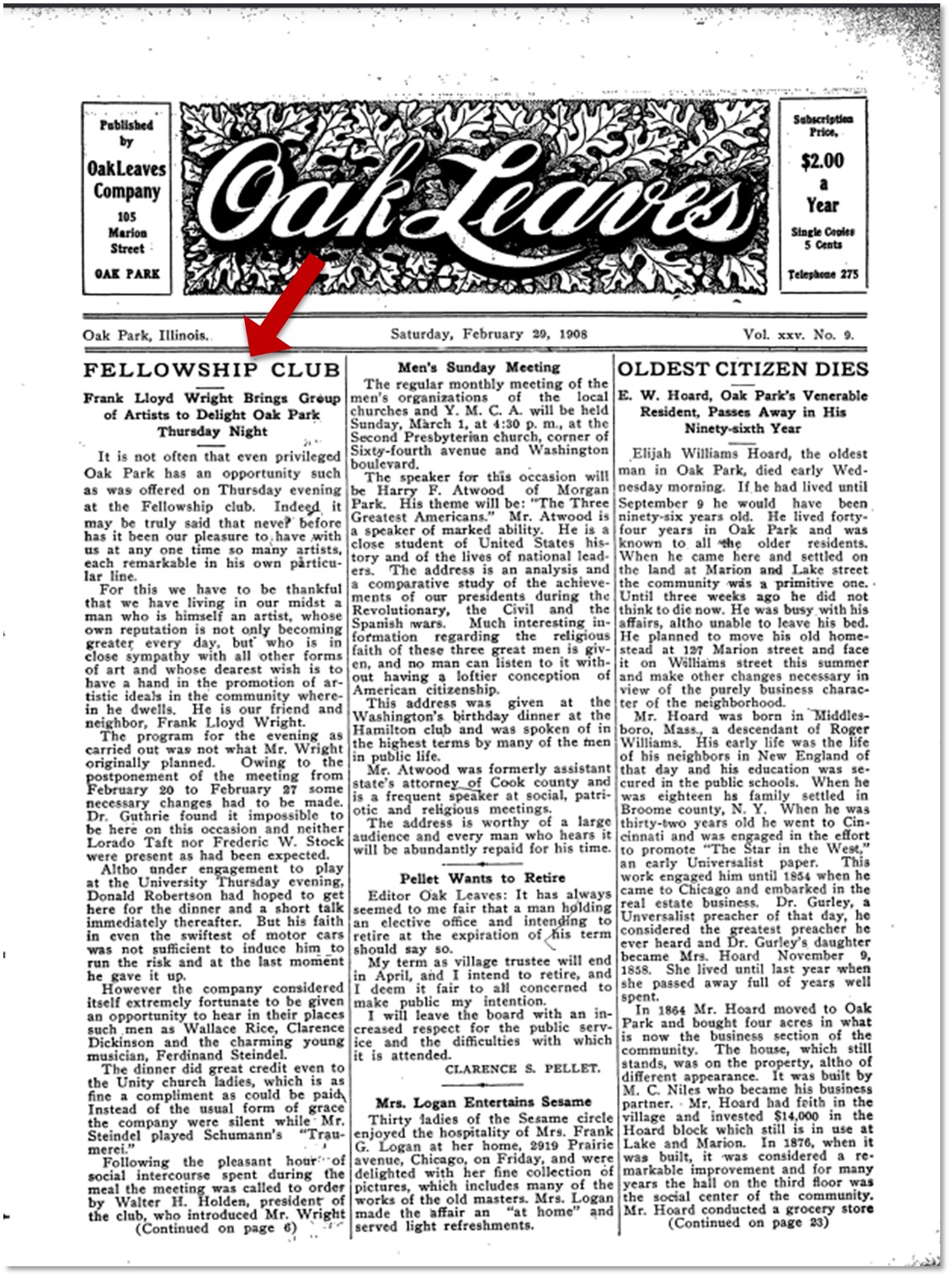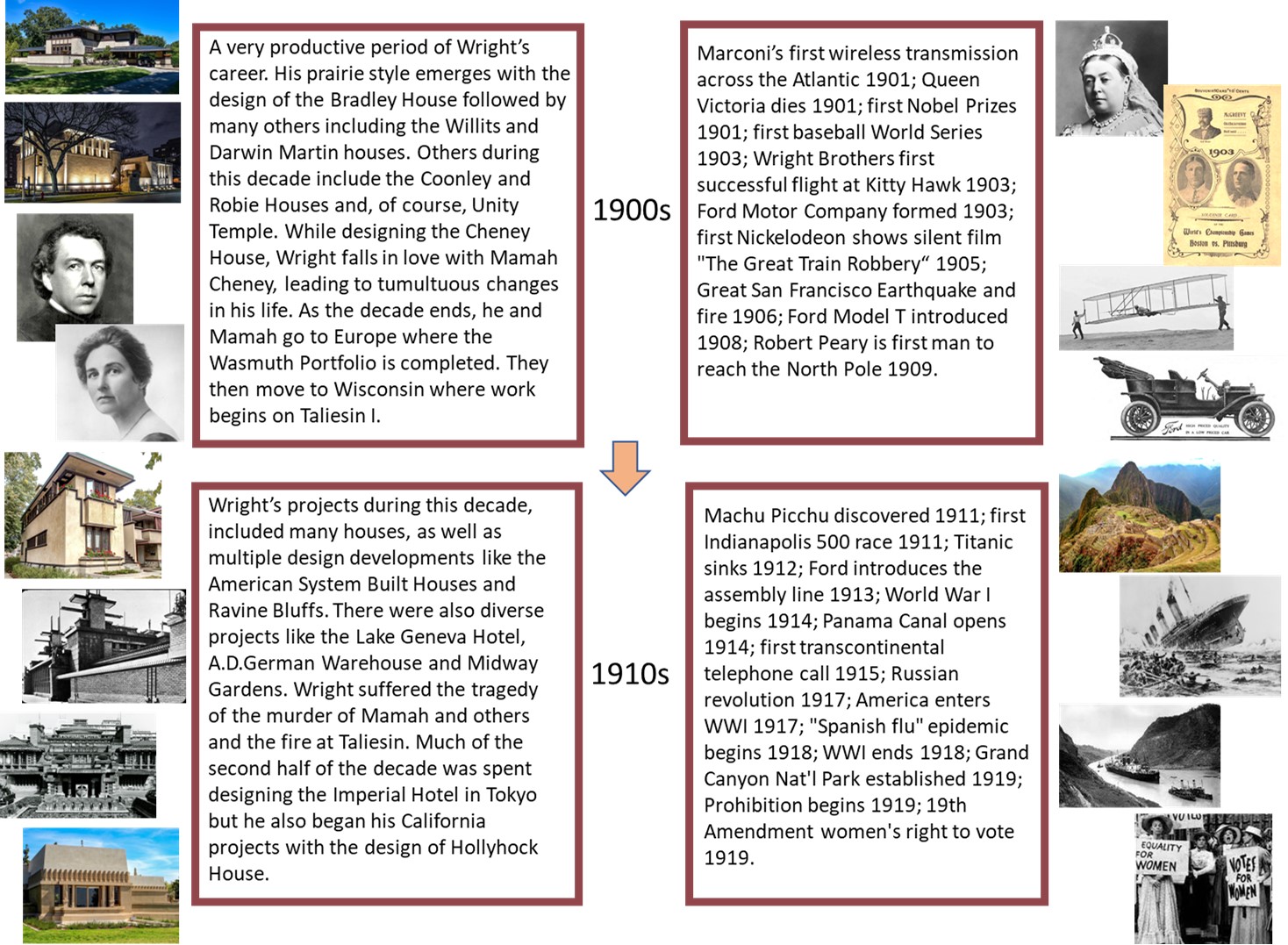Unity Temple, Continuing the Legacy as a Place to Gather
The Unity Church in Oak Park had long been a place where people from the community would come together, not just for religious services, but also for cultural, educational and social events of all kinds. An organization called the Fellowship Club, formed in 1898, met regularly at the church and hosted a wide variety of talks and entertainment functions. After the church was destroyed by fire, the group met at other locations. As soon as the Unity House portion of Unity Temple was completed, the club moved its events into that space. One of the first sessions in the new building, held on February 27, 1908, was organized by Frank Lloyd Wright. He called the event “A Symposium of Art”. An article in the Oak Leaves, the local newspaper, provided a visual description of the ambience of Unity House he planned for the symposium, “Mr. Wright will have an ample hard-wood fire in the hearth and the tables will be arranged in the fire light. There will be a grand piano cozily placed, and accomplished musicians will perform from time to time.” One can only imagine what attendees of the symposium thought as they entered into this room that was so different from other public spaces of the time, staged dramatically by Wright for this event. If only there were photographs to capture the scene.
The event was highly anticipated in the community and an announcement published in the paper a few days before the symposium stated that seating for the dinner was limited to 200 but that others would be welcome to attend afterwards to hear the speakers. Due to the deaths of two prominent members of the Unity congregation, the session was delayed a few days. This resulted in a some of the speakers invited by Wright being unable to attend. Despite that, the event was a big success. According to the Oak Leaves, “It is not often that even privileged Oak Park has an opportunity such as was offered on Thursday evening at the Fellowship Club. Indeed, it may be truly said that never before has it been our pleasure to have with us at any one time so many artists, each remarkable in his own particular line.”
The kitchen was being put to good use as dinner was prepared there for the guests by the ladies of the Unity congregation. The first speaker was William Rice, a journalist, author and editor, who in 1917, would design Chicago’s famous flag. He spoke about “the ideal reader of newspapers.” His comment about readers would today be more applicable to the social media that is the source of information for so many people; “…because of the perverted taste of the general reading public, there is no such thing as a sincere newspaper.” Next on the program was Charles Francis Browne, an artist, art critic, teacher at the Art Institute of Chicago, and one of the most popular art lecturers in Chicago. Browne had a somewhat pessimistic theme about the lack of art due to the hustle of “modern times” but asserted that Chicago was one place where there was “still a ray of hope, bright and shining.” Clarence Dickenson, a renowned organist, music teacher and choirmaster then spoke about the Musical Art Society of Chicago, which he had recently organized. This group brought together a large group of the best professional vocalists in Chicago to perform rare, complex pieces of vocal music. Last on the program was Hamlin Garland, a Pulitzer Prize winning author. Garland spoke about works of fiction and his belief that they should have a sociological background. There were also performances by young pianist Ferdinand Steindel. Steindel gained fame performing with his uncle, renowned cellist Bruno Steindel. Bruno was founding principal cellist of the Chicago Orchestra and then principal cellist with the Chicago Civic Opera. The lengthy article in the newspaper concluded, it was “… one of the most beautiful evenings ever enjoyed in Oak Park.”
The Fellowship Club continued to hold events in Unity House. In May 1908, a banquet was held to celebrate the 10th anniversary of the club. In a speech by a Chicago attorney “…Congress and the various state legislatures were given a terrific lambasting…”. Some things never change. In November 1908, the Fine Arts Society of Chicago held a lecture in the auditorium of Unity Temple, with a reception and exhibition throughout the building. The chairman of the exhibition committee was none other than Frank Lloyd Wright. Among the exhibitors was sculptor Richard Bock and Wright’s sister, Maginel Enright. A number of Wright’s clients were on the reception committee, including Mr. and Mrs. William Winslow, Mr. and Mrs. Arthur Heurtley and Mr. and Mrs. Frank Thomas.
For 115 years, Unity Temple has served as a place of inspiration, not just spiritually, but for artistic endeavors. UTRF carried on this tradition by hosting lectures, dance companies and musicians in this architectural masterpiece. As UTRF has completed its mission to fully restore the building and it is now part of a UNESCO World Heritage site, the enduring legacy of Unity Temple will continue as a place to gather in an architectural masterpiece.
By Ken Simpson









